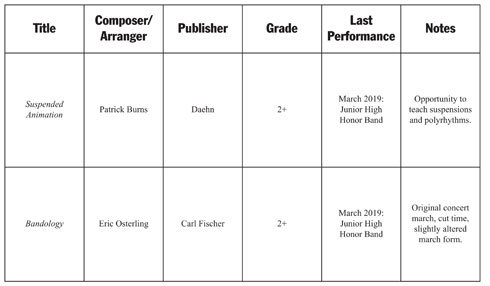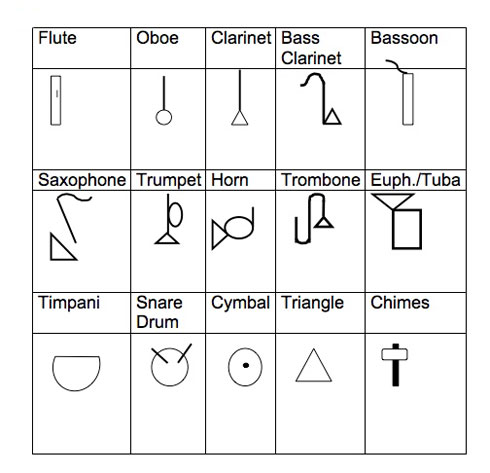Choices in music can be decidedly overwhelming, and repertoire for concert band and wind ensemble is no exception. There are pervasive lists offered in many different resources, and although these are extensive, they are exhausting rather than exhaustive. If any other subject teacher had to pick their text book each year, they would likely do so with great care and attention to their curriculum, annual goals, and expectations for scores on standardized tests. For a band director, our book changes annually alongside the personnel in our ensemble.
Although band sits outside of the restrictions placed on other academic subjects, we should still exercise great care in our selection of repertoire. Our preparation for that first rehearsal must include thoughtful choices in repertoire that reflect the knowledge of our personnel, awareness of goals for the program, and our best effort to give our students music to study and perform that is both appropriately rigorous and relevant. These choices require preparation well before school starts. Although some mid-year adjustments are necessary at points, ideally repertoire should be selected before the start of the fall semester. With myriad responsibilities beyond teaching music, the last thing any director should be doing is agonizing over a concert program. The temptation to read a large assortment of music and see what sticks is not in the best interest of students as musicians and people. Summer is the ideal time to prepare.
Repertoire Lists
While there are many state lists, recommendations, and reference books to consider, the most important repertoire list directors keep is their own. A personal list provides the perspective of what has been played, the development of the ensemble, and where students need to grow and gain deeper exposure. A repertoire list can be set up in a spreadsheet and include the title, composer, arranger, publisher, grade level, date of last performance, and notes about the work.

Repertoire Rationale
If a piece is important enough to study for two or three months, the rationale for selecting the work should be self-evident. Our rationale for selections can be grounded in a several ways beyond building and extending skills, growing the musicians in our ensemble, and meeting curricular goals. It is important that directors provide students with exposure to significant works, important styles, and pieces that strengthen and enhance wind ensemble and concert band heritage.
Our ensembles play an important role for people who attend our concerts. In some communities, our instrumental ensembles are cultural ambassadors of music from America and around the world. We must find composers representing those cultures or pieces that preserve the musical integrity of the culture. Beyond that, our ensemble can help build and sustain a culture that appreciates the arts. It should be a goal to create a balanced and satisfying musical journey for students and the community in which we teach in every concert during the year. We are responsible for building, nourishing, and sustaining a culture that demonstrates an appreciation of band music.
At points during my career when considering repertoire, I frequently return to the Ts of the rehearsal to assist with repertoire selection:
Tonality of an entire concert program and all concerts throughout the year can be considered as we review music that is major, minor, modal, and atonal.
Texture is another area important area to examine. Too many dense, heavy works can be exhausting. Too many delicate, thin pieces can fail to deliver a feeling of satisfaction for player, director, and audience.
Tempi and Time are also areas where directors can consider the wide variety available to them. These two aspects can help avoid a program with 4/4 time with a quarter note of 120 beats per minute on each piece.
Examining the Technique required to perform a work can lead a director to better understand the concepts, insights, and skills they seek to imbue into their ensembles.
Touch allows directors to consider how the artist will grow and demonstrate their ability to phrase, play with expression, and convey a style. As my colleague Jim Colonna often affirms, our ensembles create art.
Repertoire Study
Technology has provided a way for directors to access repertoire for study remotely – even on their phone. Mailings from publishers and distributors are abundant and provide a starting point. Sometimes the piece that best fits the needs of our ensemble is already in the rehearsal room. There could be hidden gems in the stacks at the back of the room, so don’t be jaded if the paper is faded. Taking time to learn one unfamiliar old score a year can be a rewarding way to develop our musicianship while cultivating an appreciation in our students for how band music has evolved and grown.
After spending 22 years in public schools, I acknowledge that time is a precious commodity for many band directors. Nonetheless, a director should be able to become familiar with many of the salient features of a work for concert band or wind ensemble within just a couple of hours of study. I have heard arguments from all sides regarding learning the score at the piano, only using solfeggio, or using a recording. I advise carving out time for both the musician and the educator in you to spend meaningful time together with the score. Our job as directors is to make decisions for communicating the artistic and pedagogical intent of the piece so the integrity of the work is realized. I am more confident in my planning and preparation when I have used all three methods previously named.
I suggest using colored pencils to mark reminders of tempi (e.g. yellow for slower, green for faster) or dynamic changes (e.g. red for increase in volume, blue for decrease). Shelley Jagow from Wright State University has excellent suggestions for marking meter I have found helpful (Jagow, 2007, p.170-171). I often use pictorial representations of instruments to remind myself regarding important entrances. I find a small picture signals my aural imagination about the change in the sound canvas of the ensemble and directs my attention to that player/section in advance of their entry. I have included several examples below.

Start Prepping Your Rep
Summer is a down season in the life of many directors. There are responsibilities for those in marching band. Elementary and middle school directors are attempting to inventory instruments or assist their high school counterparts. Hopefully, for all of you there are opportunities for much-needed relaxation and recharging with family and friends. Still, the summer provides a respite to consider how we can best help our ensembles grow into the musicians and people that we aspire for them to be. The first concert may be months away, but it is never too early to begin prepping your rep.
References
Guidelines for Style Analysis by J. LaRue (W.W. Norton, 1970).
Teaching Instrumental Music: Developing the Complete Band Program by S. Jagow (Meredith Music Publications, 2007).

.jpg)






